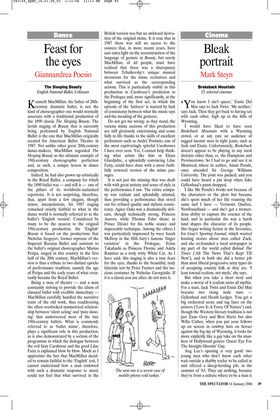Dance
Feast for the eyes
Giannandrea Poesio
The Sleeping Beauty English National Ballet, Coliseum Kenneth MacMillan, the father of 20thcentury dramatic ballet, is not the kind of choreographer one would normally associate with a traditional production of the 1890 classic The Sleeping Beauty. The lavish staging of Beauty that is currently being performed by English National Ballet is the one that MacMillan originally created for American Ballet Theatre in 1987. Not unlike other great 20th-century dance-makers, MacMillan regarded The Sleeping Beauty as the ultimate example of 19th-century choreographic perfection and, as such, a unique lesson in dance composition.
Indeed, he had also grown up artistically in the Royal Ballet, a company for which the 1890 ballet was — and still is — one of the pillars of its worldwide-acclaimed repertoire. It is not surprising, therefore, that, apart from a few elegant, though minor, interpolations, his 1987 staging remained strictly faithful to what in the dance world is normally referred to as the ballet’s ‘English version’. Considered by many to be the nearest to the original 19th-century production, the ‘English’ Beauty is based on the productions that Nicholas Sergeyev, former regisseur of the Imperial Russian Ballet and assistant to the ballet’s original choreographer Marius Petipa, staged in this country in the first half of the 20th century. MacMillan’s version is thus a tribute to two distinct epochs of performance tradition, namely the age of Petipa and the early years of what eventually became the Royal Ballet.
Being a man of theatre — and a man constantly striving to provide the idiom of classical ballet with credible immediacy MacMillan carefully handled the narrative traits of the old work, thus readdressing the often overlooked symmetrical relationship between ‘silent acting’ and ‘pure dancing’ that underscored most of the late 19th-century ballets. What is commonly referred to as ‘ballet mime’, therefore, plays a significant role in this production, as is also demonstrated by a section of the programme in which the dialogue between the evil fairy Carabosse and the good Lilac Fairy is explained blow by blow. Much as I appreciate the fact that MacMillan decided to remain faithful to the ‘English’ text, I cannot understand how a man endowed with such a dramatic response to music could not feel that what survived in the British version was but an awkward derivation of the original mime. It is true that in 1987 there was still no access to the sources that, in more recent years, have cast extra light on the reconstruction of the language of gesture in Beauty, but surely MacMillan, of all people, must have realised that there was a discrepancy between Tchaikovsky’s unique musical inventions for the mime recitatives and what survived as the corresponding actions. This is particularly visible in this production in Carabosse’s prediction in the Prologue and, more significantly, at the beginning of the first act, in which the episode of the ‘knitters’ is marred by lack of consistency between what the music says and the meaning of the gestures.
Do not get me wrong: as they stand, the various mime sections of this production are still gloriously entertaining and come fully to life thanks to the skills of excellent performers such as André Portásio, one of the most captivatingly spiteful Carabosses I have ever seen. Yet, I cannot help thinking what artists like him or Elena Glurdjidze, a splendidly convincing Lilac Fairy, could have done with a more faithfully restored version of the mime passages.
It is not just the miming that was dealt with with great artistry and sense of style in the performance I saw. The entire company was radiant and splendidly attuned, thus providing a performance that stood out for refined quality and stylistic consistency. Agnes Oaks was a dramatically delicate, though technically strong, Princess Aurora, while Thomas Edur shone as Prince Désiré for his noble stance and impeccable technique. Among the others I was particularly impressed by were Sarah McIlroy in the fifth fairy’s famous ‘finger variation’ in the Prologue, Erina Takahashi as Princess Florine and Adela Ramirez as a truly witty White Cat. As I have said, this staging is also a true feast for the eyes, thanks to the beautiful, truly fairytale sets by Peter Farmer and the luscious costumes by Nicholas Georgiadis. If it is a classic you are after, do not miss it.














































 Previous page
Previous page